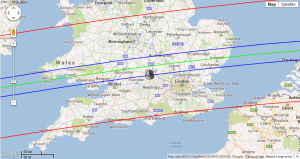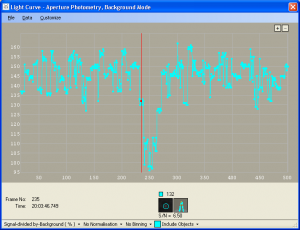This was my fourth positive asteroid occultation and my first occultation observation from my observatory. It featured a faint star (mag. 12.0) in Pisces with a bright gibbous Moon 43° distant. It was my lowest probability positive and my shortest occultation to date.
- Predicted event time was 20:03:42 UTC for my observing position.
- Predicted maximum duration was 2.5 seconds with a 3.2 magnitude drop.
- Position was 34 km south from the predicted central line in the 1-sigma zone, 11km outside the shadow path.
- Calculated probability of seeing the occultation was 16.5%.

I recorded 320ms integrations using a Watec 120N video camera on a 200mm F/4 Newtonian telescope. Video was captured via a USB2 capture device on a laptop with VirtualDub software. I used a timestamp from a Blackbox GPS video time inserter.
The asteroid was faintly visible 30 minutes before the predicted occultation using 5.12s integrations but much dimmer than the star at 320ms and so the star appeared to disappear completely. The occultation occurred just a few seconds after the predicted time.
This is the light curve for the event from video analysis in Tangra v1.3 software. The blue line is the measured intensity of the occulted star. The vertical red line marks the beginning of the occultation. Frame count on the x-axis and star intensity on the y-axis.

Nb. the timings below are corrected for internal delays in the camera and for the integration period in accordance with G. Dangl.
| Start | 20:03:46.44 | ±0.17s |
| End | 20:03:47.72 | ±0.17s |
| Duration | 1.28s | ±0.34s |
The video below clearly shows the star at the bottom of the equilateral triangle of stars in the centre of the image disappear as the fainter asteroid passes directly in front of it.
There was at least one other successful observations of this occultation and I await to see if a chord diagram is possible for this asteroid.